舞狮英文介绍 (课堂PPT)
- 格式:ppt
- 大小:6.69 MB
- 文档页数:34
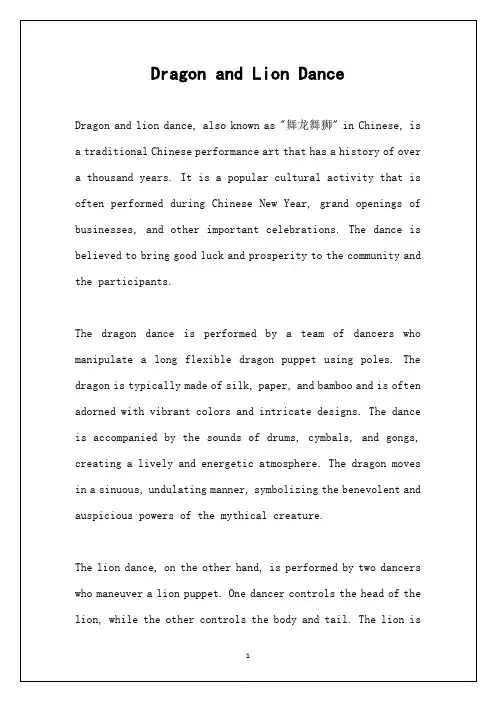

介绍中国舞狮英语作文Lion dance is a traditional Chinese cultural performance that dates back thousands of years. It is often performed during festive occasions such as Chinese New Year, weddings, and business openings to bring good luck, prosperity, and ward off evil spirits.The lion dance involves two performers inside a lion costume, one controlling the head and the other the body. The lion moves in a lively and animated manner, mimicking the movements of a lion. The performance is accompanied by loud drumming, cymbals, and gongs to create a vibrant and energetic atmosphere.The lion dance is not only a form of entertainment but also a symbol of Chinese culture and tradition. It represents strength, courage, and auspiciousness. The colorful lion and the dynamic movements are meant to bring joy and blessings to the audience.Through the lion dance, people can experience the rich cultural heritage of China and appreciate the artistry and skill required to perform this traditional dance.中文翻译:舞狮是一种源远流长的中国传统文化表演,可以追溯到数千年前。
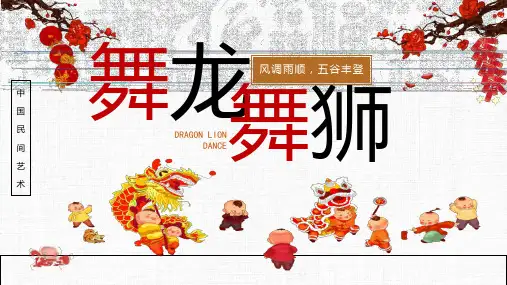
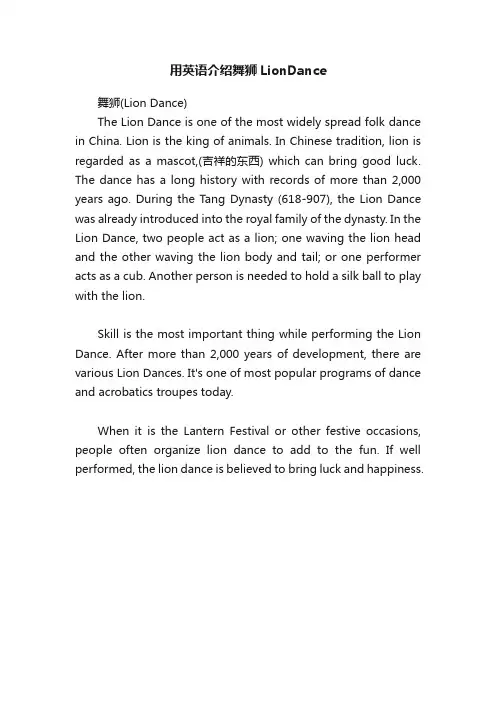
用英语介绍舞狮LionDance舞狮(Lion Dance)The Lion Dance is one of the most widely spread folk dance in China. Lion is the king of animals. In Chinese tradition, lion is regarded as a mascot,(吉祥的东西) which can bring good luck. The dance has a long history with records of more than 2,000 years ago. During the Tang Dynasty (618-907), the Lion Dance was already introduced into the royal family of the dynasty. In the Lion Dance, two people act as a lion; one waving the lion head and the other waving the lion body and tail; or one performer acts as a cub. Another person is needed to hold a silk ball to play with the lion.Skill is the most important thing while performing the Lion Dance. After more than 2,000 years of development, there are various Lion Dances. It's one of most popular programs of dance and acrobatics troupes today.When it is the Lantern Festival or other festive occasions, people often organize lion dance to add to the fun. If well performed, the lion dance is believed to bring luck and happiness.。
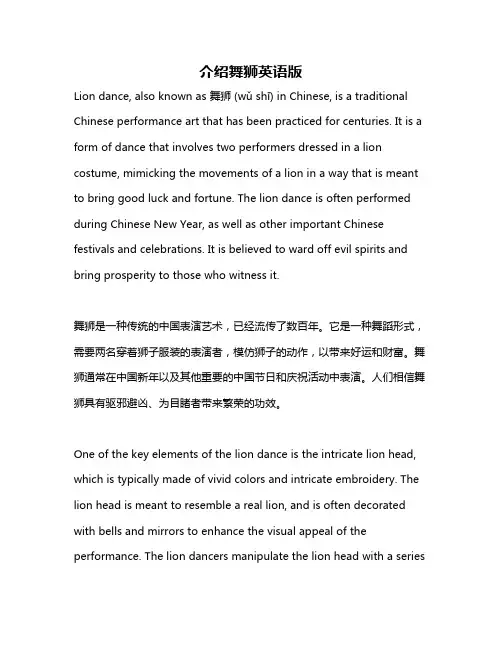
介绍舞狮英语版Lion dance, also known as 舞狮(wǔ shī) in Chinese, is a traditional Chinese performance art that has been practiced for centuries. It is a form of dance that involves two performers dressed in a lion costume, mimicking the movements of a lion in a way that is meant to bring good luck and fortune. The lion dance is often performed during Chinese New Year, as well as other important Chinese festivals and celebrations. It is believed to ward off evil spirits and bring prosperity to those who witness it.舞狮是一种传统的中国表演艺术,已经流传了数百年。
它是一种舞蹈形式,需要两名穿着狮子服装的表演者,模仿狮子的动作,以带来好运和财富。
舞狮通常在中国新年以及其他重要的中国节日和庆祝活动中表演。
人们相信舞狮具有驱邪避凶、为目睹者带来繁荣的功效。
One of the key elements of the lion dance is the intricate lion head, which is typically made of vivid colors and intricate embroidery. The lion head is meant to resemble a real lion, and is often decorated with bells and mirrors to enhance the visual appeal of the performance. The lion dancers manipulate the lion head with a seriesof intricate movements, such as opening and closing its mouth, blinking its eyes, and even wagging its tail. This level of skill and precision requires years of training and dedication on the part of the performers.舞狮的一个关键元素是精致的狮头,通常由鲜艳的颜色和复杂的刺绣制成。
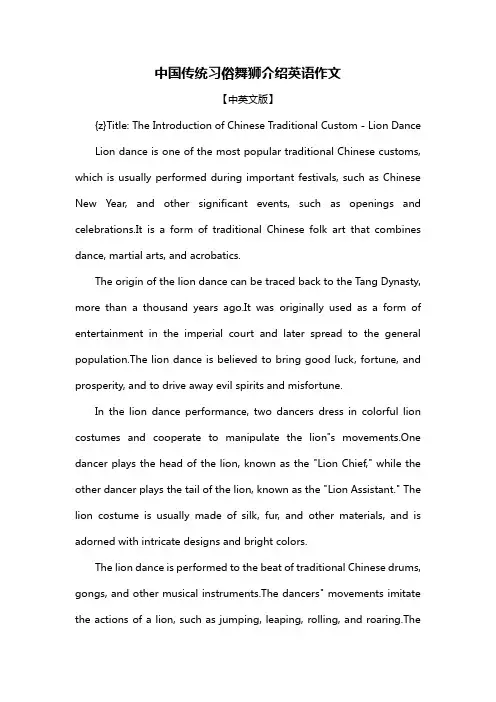
中国传统习俗舞狮介绍英语作文【中英文版】{z}Title: The Introduction of Chinese Traditional Custom - Lion Dance Lion dance is one of the most popular traditional Chinese customs, which is usually performed during important festivals, such as Chinese New Year, and other significant events, such as openings and celebrations.It is a form of traditional Chinese folk art that combines dance, martial arts, and acrobatics.The origin of the lion dance can be traced back to the Tang Dynasty, more than a thousand years ago.It was originally used as a form of entertainment in the imperial court and later spread to the general population.The lion dance is believed to bring good luck, fortune, and prosperity, and to drive away evil spirits and misfortune.In the lion dance performance, two dancers dress in colorful lion costumes and cooperate to manipulate the lion"s movements.One dancer plays the head of the lion, known as the "Lion Chief," while the other dancer plays the tail of the lion, known as the "Lion Assistant." The lion costume is usually made of silk, fur, and other materials, and is adorned with intricate designs and bright colors.The lion dance is performed to the beat of traditional Chinese drums, gongs, and other musical instruments.The dancers" movements imitate the actions of a lion, such as jumping, leaping, rolling, and roaring.Theperformance is filled with energy, excitement, and enthusiasm, and is always received with enthusiasm and appreciation by the audience.In addition to its cultural and artistic value, the lion dance also has significant health benefits.The dancers need to have strong physical fitness, agility, and coordination.The performance requires quick and precise movements, which can help improve the dancers" physical conditioning and flexibility.In conclusion, the lion dance is an important part of Chinese traditional culture and folk art.It is a unique and exciting form of performance that combines dance, martial arts, and acrobatics.The lion dance is not only a traditional custom but also a symbol of Chinese culture.It is a valuable intangible cultural heritage that should be passed down and promoted.。
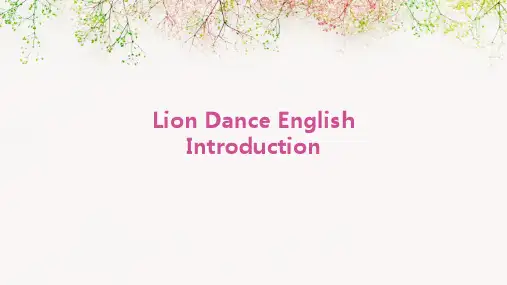
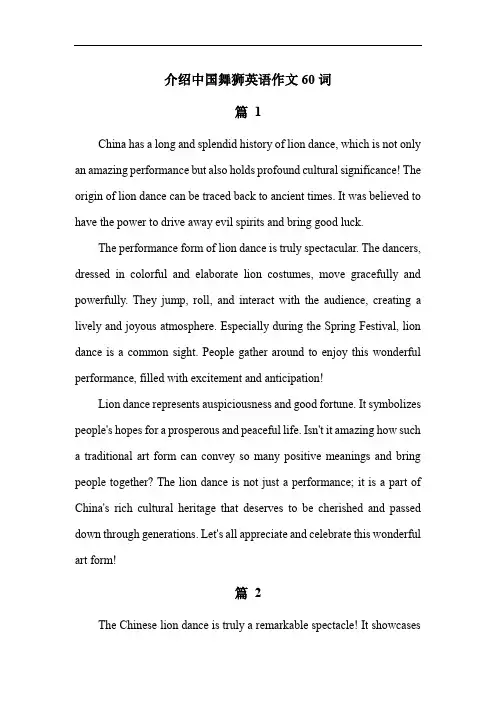
介绍中国舞狮英语作文60词篇1China has a long and splendid history of lion dance, which is not only an amazing performance but also holds profound cultural significance! The origin of lion dance can be traced back to ancient times. It was believed to have the power to drive away evil spirits and bring good luck.The performance form of lion dance is truly spectacular. The dancers, dressed in colorful and elaborate lion costumes, move gracefully and powerfully. They jump, roll, and interact with the audience, creating a lively and joyous atmosphere. Especially during the Spring Festival, lion dance is a common sight. People gather around to enjoy this wonderful performance, filled with excitement and anticipation!Lion dance represents auspiciousness and good fortune. It symbolizes people's hopes for a prosperous and peaceful life. Isn't it amazing how such a traditional art form can convey so many positive meanings and bring people together? The lion dance is not just a performance; it is a part of China's rich cultural heritage that deserves to be cherished and passed down through generations. Let's all appreciate and celebrate this wonderful art form!篇2The Chinese lion dance is truly a remarkable spectacle! It showcasesa myriad of captivating movements and features unique and splendid costumes.The movements of the lion dance are simply astonishing! The lions leap high into the air with grace and power, as if they were defying gravity. They roll and twist with remarkable agility, creating a visually thrilling display. One moment, the lion might be pouncing forward, and the next, it could be doing a series of rapid somersaults.The costumes are no less impressive. The lion's head is adorned with bright and vivid colors, often featuring bold strokes of red, gold, and green. The elaborate patterns on the head symbolize good luck and prosperity. The dancers' clothing is equally eye-catching, with flowing fabrics that add to the dynamic nature of the performance.Isn't it amazing how such a traditional art form can still capture our hearts and imaginations? The Chinese lion dance is not just a performance; it is a testament to the rich cultural heritage of our country. How fortunate we are to have such a wonderful art to cherish and celebrate!篇3Chinese Lion Dance is an amazing and captivating art form that has been an integral part of Chinese culture for centuries! It is often performed on various occasions, such as celebration events and business openings. Imagine a grand shopping mall opening! The moment the lion dance begins, a sea of people gather, their eyes fixed on the magnificent performance.The lions leap and dance with such grace and power, bringing an atmosphere of joy and excitement. Why is it so popular? Well, for one thing, the vivid movements and the colorful costumes of the lions are truly eye-catching! They represent good luck and prosperity. Also, the energetic drumbeats and the passionate gongs add to the thrilling experience. Isn't it wonderful how a traditional art form like this can still draw huge crowds and bring people together? Whether it's a festival or a new business venture, the Chinese Lion Dance never fails to charm and inspire!篇4China has a long and splendid history of lion dance. It is not only a traditional art form but also a symbol of our cultural heritage. However, the inheritance of lion dance faces some challenges in modern society. Many young people seem to be less interested in it. But fortunately, there are still some passionate young people who are committed to inheriting and innovating lion dance!For example, some young teams have combined modern music and dance elements with traditional lion dance techniques, making the performance more dynamic and appealing to the younger generation. They have also used new media platforms to promote lion dance, reaching a wider audience.The future of lion dance depends on our efforts to pass it on. We should encourage more young people to participate and create newpossibilities for this ancient art. How wonderful it would be if lion dance could continue to thrive and shine in the future! Let's work together to make it happen!篇5The Chinese Lion Dance is an extraordinary and captivating aspect of traditional Chinese culture! It is a visual feast that combines art, strength, and agility. The dancers, dressed in magnificent lion costumes, move with such grace and precision.Imagine the excitement when foreign friends witness this spectacle for the first time! Their eyes widen in amazement and their jaws drop in awe. They can't help but exclaim, "How wonderful and unique this is!" The intricate movements and the powerful beats of the drums create an atmosphere that is both thrilling and enchanting.The Lion Dance is not just a performance; it represents courage, auspiciousness, and unity. It is a heritage passed down through generations, a symbol of the rich cultural tapestry of China. Every leap and twirl of the lion conveys deep meanings and stories.Isn't it amazing how such a traditional art form can still have such a profound impact on people today? The Chinese Lion Dance truly showcases the charm and allure of traditional Chinese culture, leaving a lasting impression on all who have the privilege to experience it!。
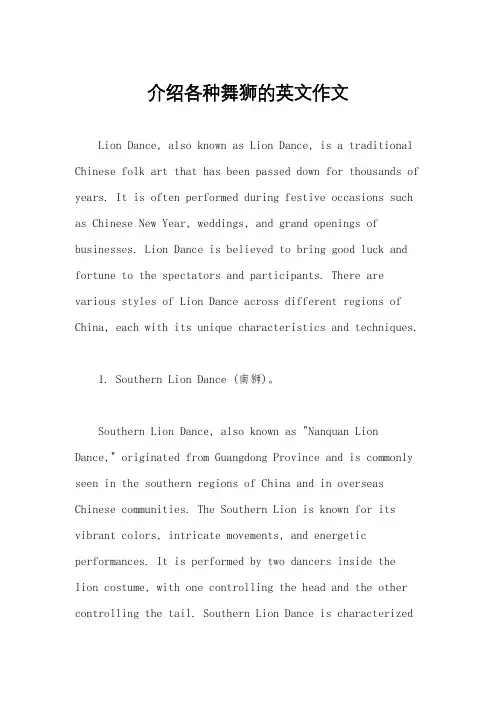
介绍各种舞狮的英文作文Lion Dance, also known as Lion Dance, is a traditional Chinese folk art that has been passed down for thousands of years. It is often performed during festive occasions such as Chinese New Year, weddings, and grand openings of businesses. Lion Dance is believed to bring good luck and fortune to the spectators and participants. There are various styles of Lion Dance across different regions of China, each with its unique characteristics and techniques.1. Southern Lion Dance (南狮)。
Southern Lion Dance, also known as "Nanquan Lion Dance," originated from Guangdong Province and is commonly seen in the southern regions of China and in overseas Chinese communities. The Southern Lion is known for its vibrant colors, intricate movements, and energetic performances. It is performed by two dancers inside thelion costume, with one controlling the head and the other controlling the tail. Southern Lion Dance is characterizedby its acrobatic stunts, such as high jumps, somersaults, and intricate footwork. The lion's movements are often accompanied by the rhythmic beats of drums, cymbals, and gongs, creating an electrifying atmosphere.2. Northern Lion Dance (北狮)。
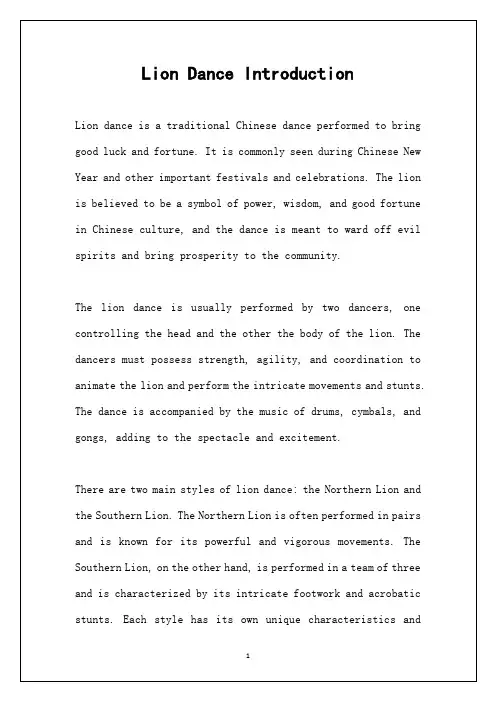
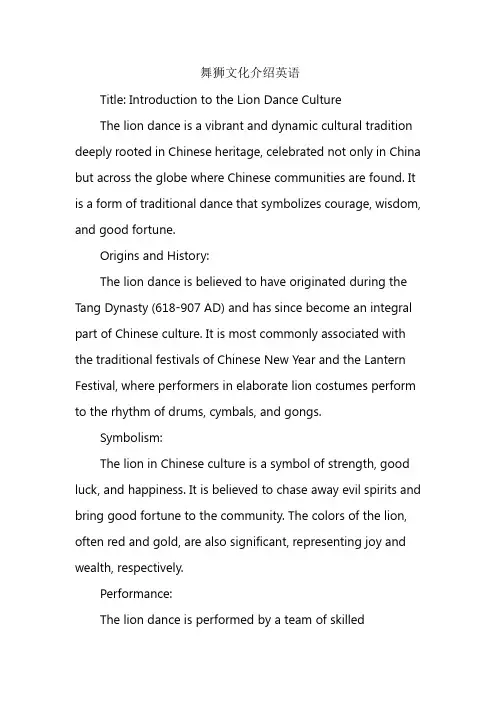
舞狮文化介绍英语Title: Introduction to the Lion Dance CultureThe lion dance is a vibrant and dynamic cultural tradition deeply rooted in Chinese heritage, celebrated not only in China but across the globe where Chinese communities are found. It is a form of traditional dance that symbolizes courage, wisdom, and good fortune.Origins and History:The lion dance is believed to have originated during the Tang Dynasty (618-907 AD) and has since become an integral part of Chinese culture. It is most commonly associated with the traditional festivals of Chinese New Year and the Lantern Festival, where performers in elaborate lion costumes perform to the rhythm of drums, cymbals, and gongs.Symbolism:The lion in Chinese culture is a symbol of strength, good luck, and happiness. It is believed to chase away evil spirits and bring good fortune to the community. The colors of the lion, often red and gold, are also significant, representing joy and wealth, respectively.Performance:The lion dance is performed by a team of skilledperformers. Two main roles exist within the dance: the lion head and the lion tail. The performers manipulate a lion costume, mimicking the movements of a real lion. The dance involves acrobatic maneuvers, jumps, and kung fu moves, requiring a great deal of strength, coordination, and agility.Costumes:The lion costumes are beautifully crafted, featuring intricate designs and vibrant colors. They are often made from silk, paper-mâché, and metal, and can weigh up to 20 kilograms. The head of the lion is particularly ornate, with large, expressive eyes, a flowing mane, and a fearsome, yet friendly, expression.Music:The music that accompanies the lion dance is as essential to the performance as the dance itself. It is lively and rhythmic, with drums setting the pace for the lion's movements. The beat of the drums signals the lion's mood, from playful and curious to majestic and powerful.Cultural Significance:The lion dance is not only a form of entertainment but also a way to preserve and promote Chinese cultural traditions. It is often performed at important events, such as businessopenings, weddings, and cultural festivals, as a means to bring good luck and blessings.Global Influence:The lion dance has transcended its cultural origins and has become a symbol of Chinese identity worldwide. It is performed by people of all backgrounds and is a celebrated art form in countries such as Malaysia, Singapore, and the United States, where diverse communities have embraced this vibrant tradition.In conclusion, the lion dance is a rich and colorful aspect of Chinese culture that embodies the spirit of strength, unity, and prosperity. It continues to be a significant cultural practice that bridges the gap between tradition and modernity, entertaining and inspiring people around the world.。
舞狮介绍英文50字Lion dance, also known as 舞狮(wǔ shī) in Chinese, is a traditional Chinese cultural performance that dates back to over a thousand years ago. It is a symbolic ritual believed to bring good luck and prosperity to the community.舞狮是一种传统的中国文化表演,起源于一千多年前。
这是一种象征性的仪式,被认为能给社区带来好运和繁荣。
The lion dance is performed during important festivals and celebrations, such as Chinese New Year, weddings, and business openings. The lion is typically controlled by two performers, with one controlling the head and the other controlling the tail, creating a synchronized and dynamic performance.舞狮通常在重要的节日和庆祝活动中表演,如春节、婚礼和商务开业。
通常由两名表演者控制,一个控制头部,另一个控制尾部,创造出一场同步而动态的表演。
The lion dance is not only a form of entertainment but also carries rich cultural and historical significance. It is a way for the Chinese community to preserve and pass down their cultural heritage to future generations, keeping traditions alive.舞狮不仅是一种娱乐形式,还承载着丰富的文化和历史意义。
介绍中国舞狮英语作文The Majestic Art of Chinese Lion DanceThe Chinese lion dance is a vibrant and colorfultradition that has been an integral part of Chinese culture for centuries. It is a symbol of good luck, prosperity, and the warding off of evil spirits. The lion dance is performed during festivals, weddings, and other special occasions, bringing joy and excitement to the crowd.The lion dance typically involves two performers, one playing the head and the other manipulating the body and tail. The lion is crafted from durable materials such as bamboo, paper, and cloth, and decorated with vibrant colors and intricate patterns. The intricate costumes and detailed craftsmanship of the lion head and body are a testament to the skill and dedication of the artists who create them.The performance begins with the lion's "awakening," where the performers gradually bring the lion to life through coordinated movements. The lion then proceeds to interact with the audience, performing various tricks and maneuvers that showcase its strength, agility, and playfulnature. The performers must have excellent coordination and physical stamina to execute the intricate moves and leapsof the lion dance.One of the most impressive aspects of the lion dance is the way it incorporates elements of martial arts. The performers often use martial arts techniques to mimic the lion's movements, giving the dance a sense of power and drama. The combination of dance, martial arts, andtheatrical elements creates a truly captivating performance.The lion dance is also a cultural exchange that brings people together. Performers from different regions and backgrounds come together to share their skills and traditions, creating a vibrant and diverse cultural landscape. The lion dance is a symbol of unity and harmony, representing the coming together of different cultures and communities.In conclusion, the Chinese lion dance is a vibrant and captivating tradition that embodies the essence of Chinese culture. It is a symbol of good luck, prosperity, and unity, and brings joy and excitement to people of all ages. The intricate craftsmanship, coordinated moves, andincorporation of martial arts techniques make the liondance a truly unique and memorable performance.中国舞狮:雄壮的艺术中国舞狮是数百年来中国传统文化中不可或缺的一部分,它充满了生机与色彩。
介绍中国舞狮英语作文1Lion dance in China is a remarkable and time - honored cultural art form with a long history. It originated in the Han Dynasty, initially serving as a ritual to drive away evil spirits and avoid disasters.The performance form of lion dance is quite fascinating. Usually, two dancers are needed to manipulate the lion prop skillfully. They make the lion jump high into the air as if it is leaping over obstacles, roll on the ground with agility which seems like the lion is playing joyfully. Their coordinated movements bring the lion to life.Lion dance holds profound cultural significance. It is an important symbol of traditional Chinese culture. During festivals and celebrations, such as the Spring Festival and Lantern Festival, lion dance performances are almost indispensable. It not only adds a festive atmosphere but also showcases the unique charm of Chinese culture to the world. People are always attracted by the vivid and energetic lion dance, which represents the vitality and positive spirit of the Chinese people.2China's lion dance is a magnificent traditional art form full of cultural significance. There are mainly two distinct styles: the Southern Lion and the Northern Lion.The Southern Lion is known for its elaborate and colorful appearance. It has a large head with a wide range of expressions, and its body is relatively long. The movements of the Southern Lion are highly dynamic and acrobatic. Dancers often jump, roll, and make quick turns, mimicking the actions of a real lion. On the other hand, the Northern Lion looks more like a real lion in shape, with a furry body and a less exaggerated head. Its movements are more gentle and smooth, often showing the lion's lazy or playful postures.The music accompanying the lion dance is also an essential part. The drumbeat plays a crucial role. A fast - paced drum rhythm usually goes along with the energetic movements of the lion, such as when it is jumping high or making rapid turns. A slow and steady rhythm, in contrast, matches the more leisurely movements of the lion.In the international arena, the lion dance has a remarkable influence. During international cultural exchange events, the vivid and exciting lion dance performance always catches the eyes of foreign friends. They are amazed by the acrobatic skills of the dancers, the unique appearance of the lions, and the harmonious combination of music and movement. It has become a symbol of Chinese culture, representing the vitality and creativity of the Chinese people.3Lion dance in China is a fascinating traditional art form.The lion used in the dance is a remarkable prop. It is typically made of bamboo frames which are light yet sturdy, providing the basic structure for the lion. Then, silk or cloth is carefully sewn onto the frame to create the body of the lion. The head of the lion is often elaborately crafted with colorful paints and sometimes even with added elements like bells or tassels to make it more vivid.The performers of lion dance have to endure arduous training. They start with basic skills such as balance and coordination. For a long time, they practice squatting, jumping and moving in unison to be able to manipulate the lion prop skillfully during the performance. It requires great physical strength and endurance as well as excellent teamwork.In different regions of China, lion dance has its own development characteristics. In Guangdong, for example, the lion dance culture is extremely rich. There are numerous lion dance troupes and competitions are held regularly. People there are deeply passionate about lion dance and it has become an important part of their local cultural heritage. In other regions, lion dance also shows unique local flavors, with different styles of movement and performance, which together contribute to the rich tapestry of Chinese lion dance culture.4Lion dance in China is a remarkable cultural heritage that embodies profound meanings. It is deeply rooted in Chinese culture, symbolizinggood luck, prosperity and harmony. In the eyes of the Chinese people, the lion is a powerful and auspicious creature, and the dynamic performance of the lion dance is believed to bring blessings.Lion dance is often performed on important occasions. During traditional festivals such as the Spring Festival and the Lantern Festival, it is an essential part of the celebration. The vibrant and energetic lion dance adds a festive atmosphere to the already joyous occasions. Moreover, it is also frequently seen in commercial events like business openings. The presence of the lion dance is thought to bring good fortune and success to the new business.The art of lion dance has been passed down through generations. There are many families who have dedicated themselves to inheriting and promoting this art form. These families take pride in their skills and pass on their knowledge and techniques from the older generation to the younger one. They not only preserve the traditional moves but also add new elements to keep the art alive and relevant in modern times. Through their efforts, the lion dance continues to thrive and fascinate people both at home and abroad.5Lion dance in China has a long and glorious history. It can be traced back to ancient times when it was initially a form of religious ritual, gradually evolving into a popular folk art. In the past, lion dance was oftenperformed during festivals and important celebrations to drive away evil spirits and bring good luck.As time went by, lion dance has continuously developed. It has incorporated many elements of martial arts. The dancers' movements are not only vividly imitating the actions of lions, but also showing the power and elegance of martial arts. For example, the leaping and crouching postures are full of strength and rhythm.In contemporary society, lion dance still plays an extremely important role. It is a crucial carrier for inheriting Chinese traditional culture. Through lion dance performances at home and abroad, people all over the world can get a glimpse of the unique charm of Chinese culture. Moreover, it also has a great significance in enhancing national cohesion. When people watch the lion dance together, they can feel a strong sense of national identity and pride, which unites the Chinese people from all walks of life.。
介绍舞狮风俗作文英语Lion Dance Ritual。
Oh, the lion dance! It's such a vibrant tradition. The performers dress up in these colorful lion costumes, and their movements are just so lively. You can feel the energy from them as they jump and leap around.You know, it's not just about the dancing. There's a story behind it too. The lion dance is often performed during festivals and special occasions to bring good luck and fortune. People believe that the lion can drive away evil spirits and bring harmony.One thing I love about the lion dance is how creativeit is. Each troupe has its own unique way of performing. Some lions are more mischievous, while others are more dignified. It's just so much fun to watch!And the music! The traditional drums and cymbals add somuch to the atmosphere. It's almost like the music and the dance are one. You can't have one without the other.So if you ever get a chance to see a lion dance performance, don't miss it! It's truly a sight to behold. The colors, the movements, the music – it all comes together to create this amazing cultural experience.。
一段介绍舞狮的文字英语Lion Dance: A Traditional Chinese Cultural PerformanceIntroduction:The lion dance is a traditional Chinese dance that is performed during festivals, celebrations, and special events. It is a unique and vibrant performance that showcases the rich cultural heritage of China. The dancers, who are usually skilled martial artists, wear lion costumes and mimic the movements of a lion, bringing good luck and fortune to the audience.Origins and Symbolism:The origins of the lion dance can be traced back to ancient China, where it was believed to ward off evil spirits and bring prosperity and happiness. The dance is often performed during the Chinese New Year and other important occasions, as it is believed to bring good luck for the coming year. The lion is considered a symbol of power, courage, and wisdom in Chinese culture, and the dance represents the lion's spirit.Costumes and Props:The lion dance costumes are usually made of colorful fabricand are designed to resemble a lion. The head of the lion is made with intricate details and vibrant colors, while the body is adorned with decorative patterns and accessories. The lion's mouth can be opened and closed, and it is operated by the dancer's movements. The lion dancers also use props such as drums, cymbals, and flags to create a lively and energetic atmosphere during the performance.Dance Movements and Techniques:The lion dance involves a series of acrobatic and coordinated movements, requiring strength, agility, and precision. The dancers must synchronize their steps and movements to create a lifelike portrayal of a lion. The dance incorporates various techniques, such as jumping, spinning, and balancing on poles, showcasing the dancers' skill and athleticism. The lion's movements are often accompanied by rhythmic music, creating a mesmerizing and captivating performance.Significance and Cultural Impact:The lion dance holds great significance in Chinese culture and is deeply rooted in tradition. It is believed to bring prosperity, good fortune, and blessings to the community. The performance also serves as a form of entertainment,captivating audiences of all ages with its vibrant colors, dynamic movements, and lively music. The lion dance has gained international recognition and is now performed in various countries around the world, promoting cultural exchange and understanding.Training and Mastery:Learning the lion dance requires years of dedicated practice and training. Dancers must develop their strength, flexibility, and coordination to perform the intricate movements with precision. They also need to understand the symbolism and cultural significance behind each step and gesture. Many martial arts schools offer lion dance classes, where students can learn the techniques and traditions associated with this ancient art form.Conclusion:The lion dance is a captivating and vibrant performance that showcases the rich cultural heritage of China. It is a symbol of power, courage, and wisdom, and is believed to bring good luck and fortune. With its colorful costumes, lively music, and acrobatic movements, the lion dance continues to captivate audiences around the world. It serves as a reminder of theimportance of preserving and celebrating cultural traditions, promoting unity and understanding among different communities.。